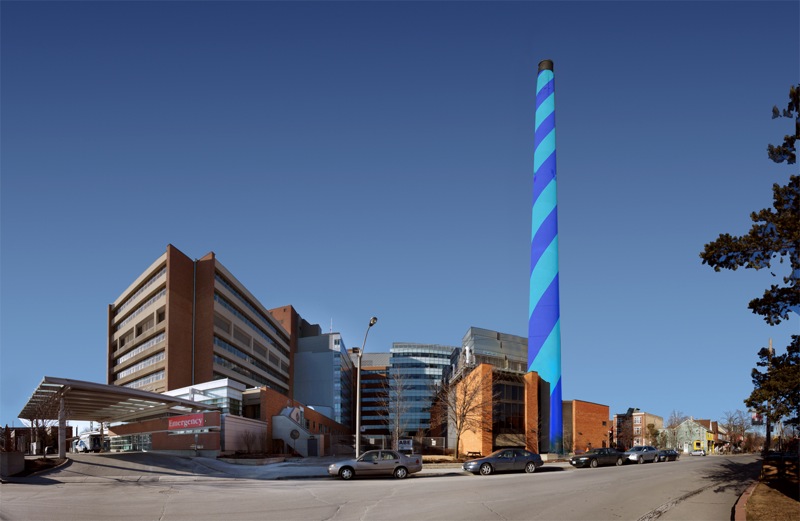By Perry King
- Artist Miklos Legrady wants to paint candy stripes on Toronto Western Hospital’s smokestack, at the cost of $675,000. Courtesy Miklos Legrady
After years of being a sticking point for local residents, the Toronto Western hospital smokestack (399 Bathurst St.) may get a facelift, if a local artist has his way.
Inspired by art projects like OCAD’s (100 McCaul St.) Sharp Centre, Miklos Legrady, at a cost of about $670,000, wants to paint the hospital’s smokestack in a candy-stripe pattern using two tonnes of blue paint.
A visual artist who works with the Centre for Contemporary Canadian Art, Legrady has been researching and discussing the Blue Spiral project with the hospital for two years. “It’s this huge industrial piece of cement and it affects the neighbourhood,” he said.
“Then after a couple years of walking by and thinking that no one will ever fund it, I started working on the documentary website for Nuit Blanche, and realized that Scotiabank spends a million and a half [dollars] on that one night of Nuit Blanche,” he said. “So it’s doable.”
Legrady’s cost estimate comes from his contact with Dynatech, an industrial painting company, that has painted the hangars at Billy Bishop Toronto City Airport. In the most likely case, Dynatech would undertake the project, providing the workers, equipment, and the insurance. Legrady says that broadcaster Dini Petty is willing to help with the fundraising, which he estimates would take two years.
“Social transformation is not necessarily their business, so they’re a little bit cautious”—Miklos Legrady
The Kensington Market Business Improvement Area has also expressed interest in the project.
“I think it’s a magnificent idea,” said chair Mika Beraket. “It would draw a lot of positive attention to the hospital for doing something so magical and childlike.
“It’s not a lot of money, it’s just paint really, and his time is free. It shouldn’t amount to a whole lot for what it would do for the neighbourhood and the city.”
But after two years of lobbying the hospital, talks with the community, and encouraging letters from the city, MP Olivia Chow’s (Trinity-Spadina) office, and the local arts community, the hospital’s position remains the same.
“I don’t think it’s a good idea to collect the money without consultation,” said Gillian Howard, media liaison for the University Health Network. Howard says that the hospital has prioritized medical research, and that a project of Legrady’s magnitude and cost could confuse corporate donors about where their contributions are being spent.
According to the hospital, even if the project was fully funded, they would still want to approach the matter systematically. This would include public consultations, filing a request for proposals and board approval. This process could take several years.
Legrady is frustrated by the hospital’s position, but he is still motivated to see the project completed. “Everybody that sees it is quite enthusiastic, except the hospital,” he said. “[The hospital] has two things going on, one is that they’ve got all kinds of people who want to have their children paint happy faces on this thing. And then, I think in a sense they are pushing me to get my political and financial backing.
“Social transformation is not necessarily their business, so they’re a little bit cautious.”
The smokestack, located at the southeast area of the property, has been at the centre of community protests for decades.
According to reports dating back to 1991 by the now-defunct [Kensington Drum ITAL] newspaper, the smokestack once emitted biomedical exhaust with no known pollution controls. Constructed in 1972, the smokestack was a regional incinerator burning waste for, at its height, 20 hospitals and 150 clinics. David Perlman, a local resident and the paper’s former editor, said the hospital had been burning toxic yellow cadmium waste bags, among other medical wastes.
Lead by the Action on Hospital Incineration (AHI) neighbourhood group, residents demanded the shutdown of the incinerator and a move to non-polluting methods of waste disposal at the hospital. By 1995, the incinerator was shut down.
According to Howard, the smokestack is now attached to the building’s mechanical system and emits only non-toxic gas.
To many local residents, the smokestack is still an ugly nightmare, but opinions on Legrady’s idea vary.
Perlman would prefer the smokestack be painted as a cigarette as a reminder of its lung polluting history, or that it be demolished altogether, but says that the project could work out if Legrady can gain a rounded view of what the community wants.
“I think it’s a weak idea,” said Peter, 60, a local artist in the neighbourhood who refused to provide his last name. “If it’s going to be painted … they should talk about the kind of medical research being done, the money being spent, all the breakthroughs and government allocations, and have that put around [the smokestack].”
“They could put a design on, but at the same time they could put out a message to people. They want to gain the people’s trust? Do something that sends a substantial message.”
Whatever the opinions, Legrady says he is doing this to help the neighbourhood transform socially. “What I’m concerned with is literally the social transformation, that people should feel a boost of positive energy and happiness when seeing this thing,” he said.

